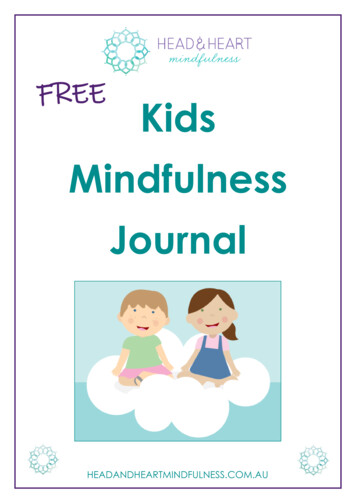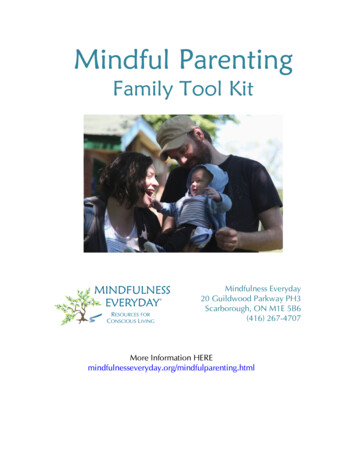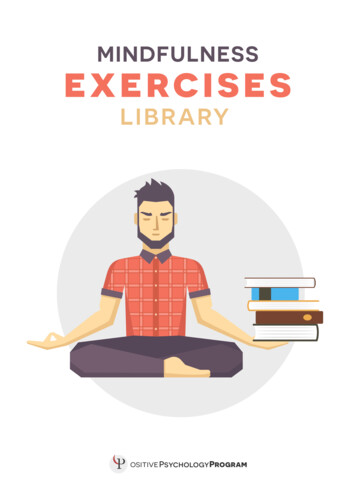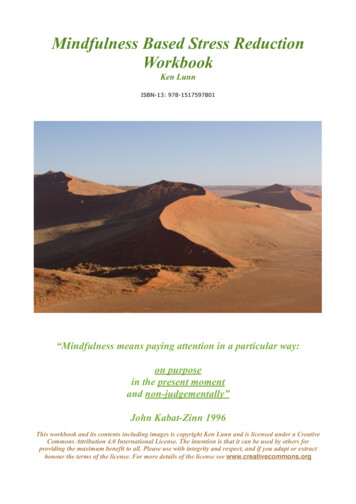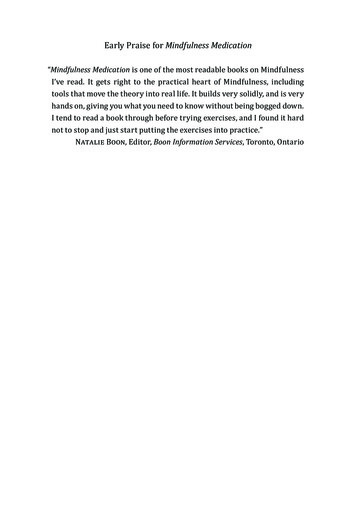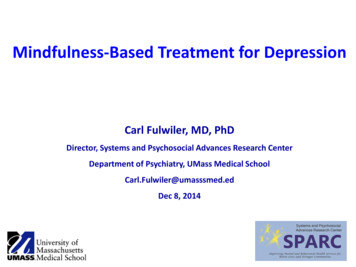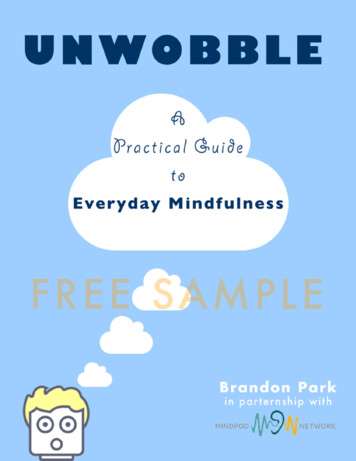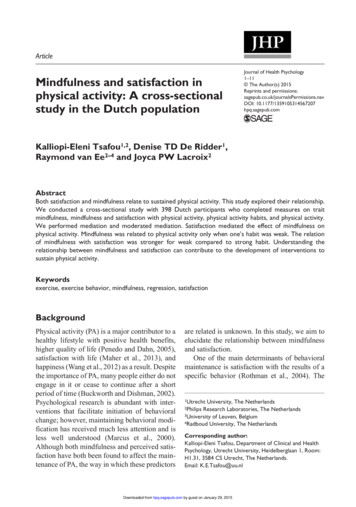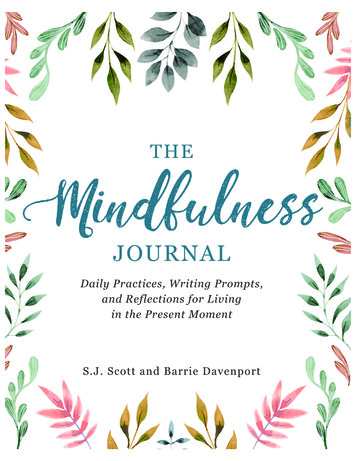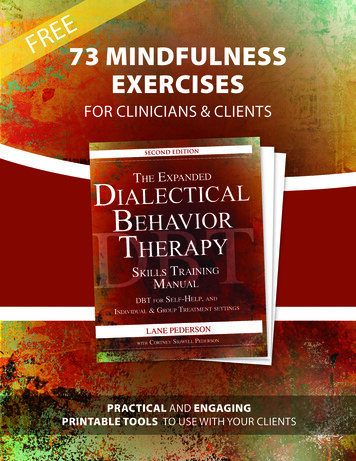
Transcription
EEFR 73 MINDFULNESSEXERCISESFOR CLINICIANS & CLIENTSPRACTICAL AND ENGAGINGPRINTABLE TOOLS TO USE WITH YOUR CLIENTS
Introduction toMindfulness ExercisesMindfulness, which is one skill set at the heart of DBT, has become extremelypopular among therapists. Yet, many therapists struggle teaching mindfulnessto clients.In essence, mindfulness is the process by which you attend to the moment,being focused and non-judgmental. In DBT, we practice this process throughmindfulness exercises.Mindfulness skills open doors to acceptance, experience, and connection to yourselfand the world. This approach is additive and allows for more complete and richerinformation and experience to guide us. It is also different from some of our defaultways of being: disconnected, judgmental, and alone. These default approachesreduce our experience because we label, categorize, and quickly move on withoutseeing and connecting to the bigger picture.Ultimately, we can use mindfulness to slow down and find peace, contentment,and enjoyment in everyday life. Share the following 73 mindfulness exercises withyour clients.
3T h e E x p a n d e d D B T S k i l l s Tr a i n i n g M a n u a lMindfulness ExercisesCORE CONCEPT: Use these exercises to practice your mindfulness skills.These mindfulness exercises will strengthen your ability to practice mindfulness andhappen to be quite enjoyable too! With all of the exercises, remember to engage eachof your senses and to take your time. The text following each exercise just scratchesthe surface. Go deeper and make the exercise your own!During your practice, when judgments, other thoughts, or any other distractionsoccur, do not fuss over them, but gently turn your attention back to the exercise.1. Explore a fruit: Use Observe and Describe to explore an orange. What arethe visual features, what does it feel like, and what does it smell like? Now,slowly start to peel the orange and continue to tune in to each sense. Notice anyemotions, thoughts, or other experiences that you have during this process, butcling to nothing, instead staying engaged in the activity. Ultimately, you maychoose to mindfully eat the orange.2. Create with Play-Doh: Study the Play-Doh container, noticing the writing,colors, and design elements. Slowly peel the lid off the container, and noticethe smell. What comes up for you? Notice any associated feelings, memories,or other experiences, and then turn your attention back to the Play-Doh. Feelit in your hands and begin to knead and work it. Notice the texture, thetemperature, and whether there are changes in its flexibility as you handle it.Experience the Play-Doh without the need to create anything. (Alternatives:Create what you choose with the Play-Doh, be it an animal, a sculpture, orsomething else. Let go of judgments as to how the creation is shaping up. Or,imagine you are a child experiencing Play-Doh for the first time. Allow yourselfto be immersed in this discovery!)3. Connect with a sound: Put on music; listen to the sounds of waves, nature, oranother soothing sound; or pick up on the naturally occurring sounds around you(the hum of an appliance, the sound of traffic, or the bustle of a workplace). Closeyour eyes and tune in to your chosen sound. Stay with the sound, returning to itwhen a distraction happens, and perhaps notice how you breathe along with it.4. Guided imagery: Use imagery from a CD, from a website, or recorded fromyour therapist or another person. Visualize that you are in the place that is beingdescribed, hearing the sounds, and feeling the other sensations. Lose yourselfin this experience, and, when the exercise is over, bring its benefits back to thepresent moment.Copyright 2017 Lane Pederson. The Expanded DBT Skills Training Manual, 2nd Edition. All rights reserved.
4T h e E x p a n d e d D B T S k i l l s Tr a i n i n g M a n u a l5. Create a safe place: Similar to guided imagery, create a place that is safe andcomfortable. It may be a room, a cabin in the woods, or an imaginary land whereyou are protected by fire-breathing dragons! Use your senses to fully enter thesafe place. Notice how it looks, paying attention to even the smallest details.Notice the sounds, or the silence. How does it feel? Stay in this place for awhile, and go there whenever you need to soothe and calm yourself.6. Sounds of a bell: Strike a bell or chime, or clang mini-cymbals to create a tone.Listen to the sound until it fades into complete silence. Repeat as many timesas you wish. This can be done anytime during the day, before meetings, beforemeals, or at any other time that you want a break or to return to the moment.7. Mindful eating: Strive to eat mindfully each time you sit down to eat. Noticeyour food, seeing the shapes, colors, and textures. Smell the aromas. Take it allin before experiencing your first small bite. Our taste buds register tastes morevividly during the first few bites. Eat these bites slowly, experiencing the tastes,smells, temperature, and textures of each bite. Chew slowly, noticing the releaseof flavors and the sensations associated with eating. Continue thoughtfully,deliberately, until you notice feeling satisfied, and then stop and reflect. As theysay, if you love food, spend some time with it!8. Mindfulness of smell: Gather a variety of scented candles or essential oils andspend some time exploring the smell of each one. Notice the differences and anyreactions you have to each kind of smell. Alternatively, disguise the labels onyour candles or oils and see whether you or others can guess each scent.9. Mindful listening: Pick a song, close your eyes, and listen closely to the music.Follow the lyrics, notice the different instruments, or take in the song as a wholeexperience. If you have heard the song before, did you notice anything new?Alternatively, pick a song that has a repetitive lyric, phrase, or melody line.Count how many times you hear the reoccurring detail.10. Mindfulness of touch: Take any object into your hands. Explore the object withyour hands and fingers, feeling the shape(s), texture(s), and temperature of theobject. This can be done in combination with vision, or done with your eyesclosed, focusing exclusively on touch. Alternatively, gather various fabrics suchas silk, cotton, wool, and velvet and experience the different feels. Of course,this exercise can be done with any collection of objects (e.g., stress ball, worrystone, sandpaper).11. Mindfulness of nature/thunderstorms: Put on a nature CD or the sound of athunderstorm. Listen and notice what emotions, thoughts, and sensations start tocome up.Copyright 2017 Lane Pederson. The Expanded DBT Skills Training Manual, 2nd Edition. All rights reserved.
5T h e E x p a n d e d D B T S k i l l s Tr a i n i n g M a n u a l12. Mindful walking: Take a walk outside or around your room. Pay attentionto the sensation of your feet in contact with the ground. Let go of thoughts,emotions, and other distractions and just walk, as if being mindful of every stepis vitally important. Alternatively, play a game and avoid cracks (or step onthem) or count steps between fixed objects such as light poles or mailboxes.13. Mindful nature walk: Take a walk outside through nature. Notice the soundsand smells. What do you see? Take this time to observe, as if this is the firsttime you have experienced this scenery and the surrounding elements of nature.When you find yourself getting distracted, come back to the scenery around you.14. Objects in a bag: Take a bag and add in various types of objects. Make surethe objects are different in texture and shape. Pass the bag around and take turnsusing your sense of touch to guess what each object is. Observe and Describethe sensations.15. Making sounds: Go around the group making funny sounds, one person at atime. Pass the sound from one person to another. Notice and release judgments,staying with the game. Alternatively, break into small groups or dyads andcreate a mantra (word or phrase to repeat) for relaxation, connection, energy,teamwork, or some other concept. Share your mantras and repeat them as a largegroup for 1 minute each, noticing the connection between the mantra and theresulting emotions and experience.16. Meditate on an object: Find something in the room to focus on and use thatobject to ground you while you breathe. It could be a painting, a vase, or anyordinary household object. Fix your gaze on your chosen object, staying with itas you breathe. If you get distracted just pull yourself back to the object of focus.17. Spaceship: Imagine you have a spaceship that can rocket you to your favoriteplace, real or imagined. Climb into your ship and count down from 10 to 1 andthen blast off to your destination. Stay at your destination awhile and practicebreathing, and then ride back home via your rocket ship or another meansfeeling relaxed and refreshed.18. Easy and enjoyable sitting mediation: Sit in a comfortable chair, on a parkbench, or out on your deck or porch. You are alive! So breathe the air, see yoursurroundings, listen to the sounds, and feel bodily sensations such as yourphysical connection to your seat, the air temperature, the breeze, etc. You haveno place to be but here. Keep it simple.19. Mindfulness apps: Search your smartphone, tablet, or computer for free orinexpensive mindfulness apps. Practice each one you find several times, andshare them with your friends and family.Copyright 2017 Lane Pederson. The Expanded DBT Skills Training Manual, 2nd Edition. All rights reserved.
6T h e E x p a n d e d D B T S k i l l s Tr a i n i n g M a n u a l20. Breathing colors: Choose two different colors, one to breathe in and one tobreathe out. Blue works well for the in-breath, since it matches the cool feelingof the air coming in. Red works well for the out-breath, as it matches the warmfeeling of the air leaving your body. However, choose the colors you want, forthe reasons you want. Close your eyes and pair each color with its breath.21. Square breathing: Start by breathing in for four seconds. Hold your breath forfour seconds, and then breathe out for another four seconds. Repeat four times.22. Deep breathing: Breathe in through your nose and out through your mouth. Toincrease focus and quiet the mind, you can use a mantra such as “in” for whenyou breathe in and “out” for when you breathe out.23. Belly breathing: Lie down on your back on the floor or in bed (preferred), or situpright in a chair. Place a hand on your belly, and as you breathe in watch howyour belly expands. Breathing in this way promotes deep breathing, which helpsto get oxygen into your system. More oxygen helps us relax our bodies and thinkmore clearly. Set an alarm and breathe deeply for a minimum of 1 minute.24. Progressive muscle relaxation: Use the classic “squeeze and release” relaxationtechnique, beginning with your toes and working all the way up to your face.Squeeze each part of your body, holding the tension for a couple of seconds, andthen release. Notice both the state of tension for each body part as well as thestate of release. Although this exercise works best using your whole body, it canalso be condensed to use fewer body parts, such as just squeezing and releasingyour hands (making fists and then shaking them out), or by just scrunching upyour face before relaxing it. For more directions, search for progressive musclerelaxation scripts online or on YouTube.25. Body scan: Use Observe and Describe to scan your body from top to bottom,noting areas of tension and discomfort. Gently dismiss judgments that arise,and take a deep breath into each area of the body where this discomfort exists.Do not have an agenda about changing how these areas feel, but do noticedifferences that happen as you continue to breathe and connect. Also, noticeareas of your body that feel relaxed and comfortable. Breathe into these areastoo.26. Rigid body/relaxed body: Stand and tighten your body, assuming a rigid andstiff stance. Hold that pose for 10 seconds or more. Then, relax your body andassume a loose, flexible, and comfortable stance. Identify the different emotionsand sensations that came up with each pose.Copyright 2017 Lane Pederson. The Expanded DBT Skills Training Manual, 2nd Edition. All rights reserved.
7T h e E x p a n d e d D B T S k i l l s Tr a i n i n g M a n u a l27. Half-smile (or full smile): Sit in a chair and take a couple of deep breaths. As youcontinue to breathe, slowly start to turn the sides of your lips upward to make asmall smile. Relax your face and take on this more serene look. Notice whetheryour emotions begin to change, as your face communicates acceptance to yourbrain. Alternatively, look in a mirror, make a peace sign with your first and middlefingers, and use those fingers to push up the sides of your mouth into a goofysmile. This moment need not be so serious, even if your life sometimes is!28. Positive memories: Remember a positive event from your life, and useyour imagination to transport yourself back to that time and place. Play it inyour mind as if it is a movie, and tune in to your senses to fully enter intothe memory. Notice what emotions come up as you immerse yourself in theexperience. Let this positive memory have an impact on you.29. Compassion for others: Think of a person who has offended you or otherswith his or her behavior. Imagine what factors would lead a person to behave inways that hurt or put off others. Or imagine that person as a child or a baby withinnocence. Send this person compassion from your heart, wishing them well inthis world. Does sending compassion feel different from holding on to painfulfeelings about this person?30. Pictures and judgments: Look at photos in a magazine and describe whatcomes to mind. What judgments do you notice? Now take a second and describewhat you see in a matter-of-fact manner, sticking to the facts. Notice thedifference in the experience.31. Gratitude lists: Make a gratitude list with everything you can think of on it,both big and small. Mediate on the list for several minutes. Note any changes inyour emotions. Alternatively, write a thank-you letter to someone, being specificabout what the person did to receive your gratitude.32. 5, 4, 3, 2, 1 senses: To increase your awareness and ground yourself in thepresent moment, list five things you see, four things you hear, three things youfeel, two things you smell, and one thing you taste.33. Standing like a tree: Stand up and pretend your legs are the roots of a tree,reaching your arms up to be the branches. Start to sway side to side as if you areblowing in the wind. Notice that your legs don’t move, keeping you grounded.Imagine yourself being a tree when the winds of life whip up. Be flexible yetgrounded, like a strong tree weathers a storm.Copyright 2017 Lane Pederson. The Expanded DBT Skills Training Manual, 2nd Edition. All rights reserved.
8T h e E x p a n d e d D B T S k i l l s Tr a i n i n g M a n u a l34. Finding your center: Sit upright in a comfortable position and take several deepbreaths. On the next exhale lean as far to the right as you can without fallingover. Inhale and return to center. Then exhale and lean far to the left. Inhale to thecenter. Slowly start to repeat, leaning less and less every time. When you finallyreach the middle, your center, take several deep breaths and notice what it feelslike to be in balance.35. Seeking clarity: Take a jar, fill it with water, and put in fine sand, glitter, oranother substance that can be shaken up. Once the lid is tight, shake up the jar.Notice the chaos as the sand or glitter moves about the water, with the waterbeing cloudy or unclear. Then, mindfully watch as everything slowly settles,ultimately bringing clarity to the water. Think about the parallels betweenEmotion Mind and chaos compared to Wise Mind and clarity.36. Yoga: Take 5 minutes and assume simple yoga poses (check out a book or videoon yoga). Notice your body and remember to breathe as you hold each pose.Just notice emotions, thoughts, and sensations that arise, clinging to none. Withpractice, this exercise is grounding and relaxing, and promotes regulation ofbody and mind.37. Mandalas and coloring books: Mediate on the process of coloring, losingyourself in the activity.38. Simon says: This game is all about focusing and sustaining attention.Remember to let go of judgments and have fun!39. Jenga: Focus with one mind as you remove blocks and build the tower higherand higher. Notice your connection to removing and stacking the blocks,immersing yourself in the activity. When the tower tumbles, remember that thisis the natural outcome of the game.40. Categories: Pick a category such as animals or foods and list as many itemsfrom that category as possible. In a group setting, go around the circle with eachperson repeating the items already listed before adding to the category.41. Picnic game: Start with the phrase “I am going on a picnic and I’m bringing. . .”Go around the circle with each person adding something they are bringing, butonly after he or she has said all the items that were mentioned before, in order.For an added challenge, this game can be played listing items from A to Z.42. Riddles: Buy a book on riddles or search for them online. Contemplate possiblesolutions. An example: “I am an ancient invention that allows people to seethrough walls. What am I?”Copyright 2017 Lane Pederson. The Expanded DBT Skills Training Manual, 2nd Edition. All rights reserved.
9T h e E x p a n d e d D B T S k i l l s Tr a i n i n g M a n u a l43. 20 Questions: Play 20 questions with a friend, a child, or your family.44. Untie knots: Start with string or a shoelace that has been tangled and knottedup. Start to untangle and untie the knots. What emotions come up. Frustration?Impatience? Breathe and practice acceptance as you mindfully complete thisactivity.45. Blow bubbles: Blow bubbles and watch as they float through the air, eventuallypopping. Notice sensations, such as your breathing, the air you blow into thebubble, and any emotions that arise from the activity.46. Play catch: Play this simple game with the goal of being in the moment.47. Play catch with categories: Take one ball to throw around a group of peoplestanding in a circle. Pick a category such as countries, music artists, or moviestars. Every time someone catches the ball, they add to the list. If a personcannot add to the list, he or she can create the next category and continue thegame.48. Energy ball: Imagine a ball as a source of negative emotional and mentalenergy. Hold on to the ball in your hand and take some time to process what itis like to hold on to your negative energy. Do you want to continue to hold onto it? Tell yourself that you have the choice to let the ball go and put it down.Alternatively, decide to bounce the ball off the floor or wall, imagining thenegative energy leaving the ball with each bounce, until the ball becomes neutralagain.49. I spy memory game: Find a page in a magazine full of various objects andtake 1 minute to mindfully look over the page. After the minute is up, close themagazine and write down all of the things that you remember.50. Write with your nondominant hand: Create an encouraging or copingstatement and write it out 10 times with your nonwriting hand. Notice anyfrustrations or judgments that come up and practice releasing them. Engage inthe process, noting the level of focus needed to have the writing be legible.51. Attention to small moments: Small moments in our lives include those that wedo not typically notice and those we take for granted. A small moment may behaving a cup of coffee or a cool glass of water, spending a moment with a childor pet, or performing any everyday activity that goes by without our attention.Enjoyment, peace, and serenity in life happen in the small moments. Each hour,orient yourself to the small moments that you might otherwise miss.Copyright 2017 Lane Pederson. The Expanded DBT Skills Training Manual, 2nd Edition. All rights reserved.
10T h e E x p a n d e d D B T S k i l l s Tr a i n i n g M a n u a l52. Focus on senses: Take time to notice what comes through your five senses:what you see, hear, smell, taste, and/or touch. Your senses are your gateway tothe world. (See Self-Soothe in Module 3: Distress Tolerance.)53. Breathing: We all breathe, and we can all breathe more effectively. Our breathis our anchor and is an excellent way to center ourselves. Take time to breathemindfully in and out. Stay focused on the sensation of the air coming into yourair passages and lungs, holding it, and then letting it out. Use a mantra, such as“in” as you breathe in and “out” as you breathe out, or count each breath from 1to 10, starting over when you reach 10 or if you lose count.54. Breathing life cycle: Another way to breathe mindfully is to notice thebeginning, middle, and end of each inhalation and exhalation (like how you canhear the beginning, middle, and end of sounds—another mindfulness exercise).Concentrate on the life of each breath going in and out.55. Quiet/still time: Set time aside each day to be quiet and to experience that quiet.Be One-Mindful with the stillness, finding your center and noticing comfort inthe moment.56. Your favorite song (or album): Listen to your favorite song or album with yourfull attention. Listen closely to the lyrics and their meaning. Be mindful of eachword and phrase. Listen to the sounds of the different instruments. Pay attentionto the guitar, bass, drums, vocals, or any other instrument that is central to themusic. Notice the production values: Is the song basic or elaborate? Bare bonesor highly orchestrated? Be mindful of things you have never noticed in musicyou have listened to many times.57. Your favorite show: Watch your favorite TV show, paying attention to thesmall details. Notice what the actors are wearing, how the sets are designed anddecorated, and other elaborate details that go into your show.58. The room you know so well: Observe and Describe details that you nevernoticed about your bedroom, living room, office, or any other place in whichyou have spent a significant amount of time.59. 10 details: Anyplace, anywhere, pause and Observe and Describe 10 details youwould not have otherwise noticed.60. Turn down the noise (or embrace it): Turn off all extra sources of noise inyour home. If you are not mindfully listening to the radio or TV, turn it off. Workon being present without the competition for your attention. If you are unable toturn down certain noises, practice being mindfully aware of them, noticing themwithout judgment.Copyright 2017 Lane Pederson. The Expanded DBT Skills Training Manual, 2nd Edition. All rights reserved.
11T h e E x p a n d e d D B T S k i l l s Tr a i n i n g M a n u a l61. People (or anything) watching: Be a watcher of people, or of anything thatmight hold your interest. Remember not to judge what you see, but simply let itinto and out of your experience like clouds floating through the sky.62. One chore/one task: Do one chore or one task, such as washing the dishes orfolding laundry, with all of your attention and care. Be One-Mindful with theexperience without adding or subtracting.63. “Holding” a feeling: Hold your present feeling like it is a baby. Calming adistraught baby involves compassion and One-Mindfulness. Babies can tellwhen we are either frustrated or do not want to be with them in the moment.Our feelings are like babies: They too can tell when we either reject them or arenot fully present with them. Holding your feeling and being mindful of it willusually cause it to diminish in intensity. If not, consider distraction skills.64. Interconnection: Contemplate how you are connected to all of the items aroundyou, to your surroundings, to all of the people in your life, and/or to the universein general.65. Relative thinking: Contemplate the upsides and downsides of any judgmentwithout sticking to any conclusions. See how “good” and “bad” depend on thecircumstances and are not fixed.66. 5/60: Plan 5 minutes out of every hour to engage in a mindfulness activity. Thismay include breathing, doing a scan of your body for tension and then relaxing,or one-mindfully accomplishing any task.67. Find your center: Before engaging in thoughts and behavior, spend a momentto breathe and find your center. Know that finding your center helps you toaccess your Wise Mind. Practice the directives of the mantra: Pause, breath,center . . . enter.68. Write and release: Write what you would like to let go of on paper and shredit, burn it, or place the paper under water and watch the ink wash away anddisappear.69. Lie in the grass: On a day with nice weather, find a patch of lush, green grass inyour yard or a park. Lie down, close your eyes, and turn your attention towardthe connection and sensations between your body and the grass, feeling yourselfsupported by the ground. Breathe in the sensations and stay there awhile.Following the exercise, notice what you are feeling. Alternatively, keep youreyes open and gaze at the sky, watching the clouds float into and out of yourfield of vision. Contemplate the connection between yourself, the earth, and thesky. Take your time in this place, and breathe.Copyright 2017 Lane Pederson. The Expanded DBT Skills Training Manual, 2nd Edition. All rights reserved.
12T h e E x p a n d e d D B T S k i l l s Tr a i n i n g M a n u a l70. Practice compassion for yourself and others: Sit or lie down in a comfortablespot, and turn your attention to your breathing. As you breathe say to yourselfover and over, “May I experience peace and happiness.” Once you have settledinto mediating on this mantra, change the mantra to focus on another person bysaying, “May (Person) experience peace and happiness.” Continue to breathe asyou meditate on this thought from your heart. Extra credit: Make the person youwish peace and happiness to someone you dislike.71. Report on your experience or surroundings: Write or narrate what ishappening right now with your emotions, thoughts, physical sensations, and/orbehavior. In doing so, pretend that you are a reporter giving an objective accountto your audience. Notice what it is like to Observe and Describe your experiencein this somewhat detached manner.72. Explain a task (and then participate in it): Take any daily task or chore, suchas making coffee, sweeping a room, or watering plants, and break it down intoits component steps. Imagine that you would have to explain how to do this toa child or even an alien, and go into minute detail. Now, actually engage in thetask or chore, noticing each step and participating in it mindfully.73. Look through a new window: Pick a window in your home, school, or officethat you never (or almost never) look through. Sit down and spend 5 or moreminutes gazing through the window, observing what is outside. Notice thescenery and whether anything is happening outside the window. Describe thescene and/or action to yourself and connect with it. Extra credit: Contemplatethe “windows” in your life you do not or refuse to look through. What wouldyou notice if you chose to look through one or more of these windows?Copyright 2017 Lane Pederson. The Expanded DBT Skills Training Manual, 2nd Edition. All rights reserved.
Award WinningThis second edition is the mostcomprehensive and readable DBTmanual available with more skills thanany other DBT book on the market.Beyond updates to the classic skillsmodules, clients and therapists will beenriched by added modules that includeDialectics, Cognitive Modification,Problem-Solving, and Building Routinesas well as all-new, much-needed moduleson addictions and social media.Designed for DBT therapists, eclecticand integrative therapists, and as aself-help guide for people interested inlearning DBT skills, the straightforwardexplanations and useful worksheetscontained within make DBT skills learningand practice accessible and practical forboth skills groups and individual users.Order Your Copy Today atwww.pesi.com/DBTWorkbook800-844-8260
Mindfulness, which is one skill set at the heart of DBT, has become extremely popular among therapists. Yet, many therapists struggle teaching mindfulness to clients. In essence, mindfulness is the process by which you attend to the moment, being focused and non-judgmental. In DBT, we practice this process through mindfulness exercises.
